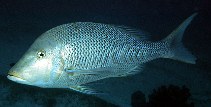| Family: |
Lethrinidae (Emperors or scavengers), subfamily: Lethrininae |
| Max. size: |
87 cm TL (male/unsexed); max.weight: 8,400.0 g; max. reported age: 28 years |
| Environment: |
reef-associated; brackish; marine; depth range 10 - 75 m, non-migratory |
| Distribution: |
Indo-West Pacific: Red Sea, Persian Gulf and East Africa to southern Japan and Samoa. According to a genetic study (Ref. 28017), Lethrinus nebulosus and Lethrinus choerorynchus are two distinct species in Western Australia. |
| Diagnosis: |
Dorsal spines (total): 10-10; Dorsal soft rays (total): 9-9; Anal spines: 3-3; Anal soft rays: 8-8. This species is distinguished by the following characters: body moderately deep, its depth 2.5-2.9 times in standard length; head length 0.9-1 times in body depth, 2.6-3.1 times in SL, dorsal profile near eye nearly straight, or in large individuals, distinctly concave; snout moderately long, its length about 1.8-2.4 times in HL, measured without the lip the snout is 0.8-1 times in cheek height, its dorsal profile nearly straight or concave, snout angle relative to upper jaw between 50° and 68°; interorbital space usually convex; posterior nostril an oblong longitudinal opening, closer to orbit than anterior nostril or, about halfway between orbit and anterior nostril eye not close to dorsal profile except in small individuals, its length 3.6-5.9 times in HL; cheek moderately high, its height 2.4-3 times in HL; lateral teeth in jaws rounded with points or molars that often have tubercles; outer surface of maxilla smooth or with a longitudinal ridge; D X, 9 with the 4th or 5th dorsal-fin spine usually the longest, its length 2.7-3.6 times in body depth; A III,8 with the first soft ray usually the longest, its length almost equal to or slightly shorter than length of base of soft-rayed portion of anal fin and 1.3-1.6 times in length of entire anal-fin base; pectoral-fin rays 13; pelvic-fin membranes between rays closest to body usually with dense melanophores; cheek without scales; 46-48 lateral-line scales; 5 ½ scale rows between lateral line and base of middle dorsal-fin spines; 16-17 scale rows in transverse series between origin of anal fin and lateral line; usually 15 rows in lower series of scales around caudal peduncle; 5-9 scales in supratemporal patch; inner surface of pectoral-fin base densely covered with scales; posterior angle of operculum fully scaly. Colour of body yellowish or bronze, lighter below, centers of many scales with a white or light blue spot, sometimes irregular dark indistinct bars on sides and a square black blotch above pectoral fins bordering below lateral line; 3 blue streaks or series of blue spots radiating forward and ventrally from eye; fins whitish or yellowish, pelvic fins dusky, edge of dorsal fin reddish. Juveniles variable with blotches or stripe and changes with habitat (Ref. 114226). |
| Biology: |
Inhabit coral reefs, coralline lagoons, seagrass beds, mangrove swamps, flat sand bottoms, and coastal rock areas. Adults solitary or in small schools; juveniles form large schools in shallow, sheltered sandy areas, also harbors where seagrasses, algae or sponge habitats are found at various depths. Feed on echinoderms, mollusks and crustaceans, and to some extent on polychaetes and fish. The reproductive nature of spangled emperors is uncertain, although they also may be protogynous hermaphrodites (Ref. 27260, 55367). However, recent study classified juvenile hermaphroditism for this species wherein transition from ovary to testis occurs before ovarian maturation, hence, no true sex-reversal in the sense of protogynous hermaphroditism is observed (Ref. 107020). May have a coppery or iodine taste or smell in the Indian Ocean (Ref. 2295, 11888). It has been shown that this species can survive for long periods in salinities as low as 10 parts per thousand and therefore it is a potential estuarine aquaculture species (Ref. 2295). Taken by handline, traps, trawls, seines, and gill nets. Marketed mostly fresh. Very important commercial and sport fish in some countries (Ref. 68703). |
| IUCN Red List Status: |
Least Concern (LC); Date assessed: 11 July 2023 Ref. (130435)
|
| Threat to humans: |
reports of ciguatera poisoning |
Source and more info: www.fishbase.org. For personal, classroom, and other internal use only. Not for publication.
